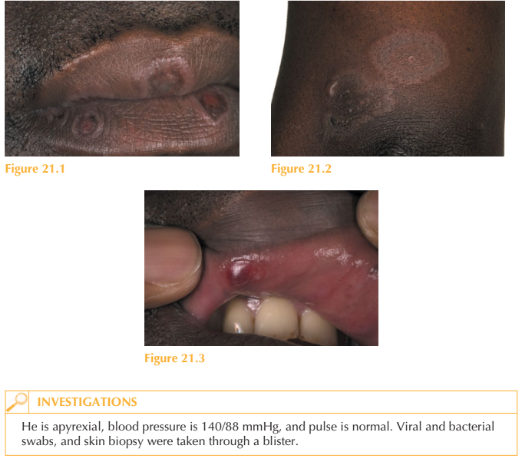History
A 39-year-old man is referred by his GP to the on-call dermatologist with a 3-day history of a sore throat, painful mouth and blistering rash. One week prior to the onset of his painful mouth and rash he developed a sore on his upper lip. The sore on his upper lip and widespread blistering eruption had first occurred at the age of 7 years and had erupted on four previous occasions. He feels well in himself but is having difficulty eating due to his painful mouth. His past medical history includes diet-controlled diabetes, hyperten-sion and hypercholesterolaemia. He was commenced on amlodipine and sim vastatin two years previously.
Examination
Annular target-like lesions are seen over his lips (Fig. 21.1) and blistering annular lesions over his hands, elbows and trunk (Fig. 21.2). Within his mouth are painful blisters (Fig. 21.3) and eroded erythematous ulcers.

Questions
• What is the underlying diagnosis and what secondary phenomenon has occurred?
• How would you treat the patient initially?
• What management would you instigate to prevent further similar attacks?
When patients present with a sore ulcerated mouth the differential diagnoses include aphthous ulcers, viral stomatitis such as caused by herpes simplex virus (HSV), shingles (herpes zoster virus), Behçet’s disease, immunobullous disease (pemphigus vulgaris), vita-min/iron deficiency, neutropenia, and adverse drug reactions. The clue to the underlying cause of this patient’s oral ulceration was the preceding sore on his upper lip – herpes labialis (‘cold sore’) caused by HSV type 1 was isolated from a viral swab. Subsequent to his HSV infection he developed erythema multiforme (EM). This manifested in this patient as oral ulceration and target lesions on his lips and focal skin sites. Histology of the skin biopsy showed marked dermal oedema and subepidermal blisters containing neutrophils and eosinophils. Target lesions of EM are typically seen on the face, elbows, knees, palms and soles (so-called ‘acral sites’). The lesions themselves consist of erythematous annular rings with a central papule or vesicle. However, as the name suggests, the cutaneous eruption can be variable in appearance (multiforme). With EM there may or may not be involvement of mucous membranes. EM minor is cuta-neous involvement at the typical acral sites; EM major has the same cutaneous eruption (10 per cent epidermal detachment) plus involvement of one or more mucous mem-brane sites. This can be distinguished from Stevens–Johnson syndrome that has 10–30 per cent skin surface area with epidermal detachment and always significant mucous membrane involvement. Drugs rather than infections are more commonly associated with the onset of Stevens–Johnson syndrome. The cause of EM is usually an infection rather than a medication, with HSV and Mycoplasma pneumoniae most commonly implicated. This patient presented too late to be treated with aciclovir for his herpes labialis (which should be initiated in the first 72 hours to be effective), however he was commenced on aciclovir 400 mg daily as secondary prophylaxis against further episodes. Moderately potent topical steroid was applied to all the EM lesions and he rinsed his mouth with the NSAID benzydiamine hydrochloride (Difflam) mouthwash, four times daily. Some patients develop recurrent EM despite prophylactic aciclovir. In these cases a systemic immunosuppressive agent such as azathioprine or ciclosporin may be needed to prevent further attacks of EM.
KEY POINTS
• Erythema multiforme (EM) is a reactive skin eruption that is usually the result of an underlying infection.
• Although the appearance of the skin lesions can be variable, target-like lesions at acral sites are classically seen.
• EM with mucous membrane involvement (lips, genitals, nose) is termed EM major.
need an explanation for this answer? contact us directly to get an explanation for this answer